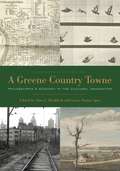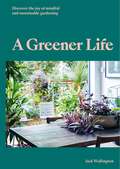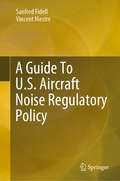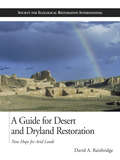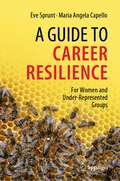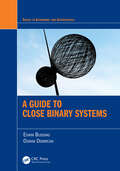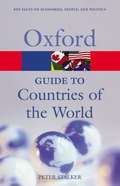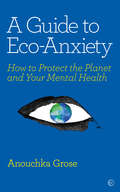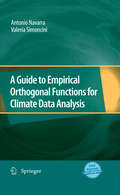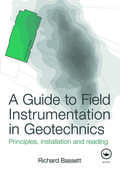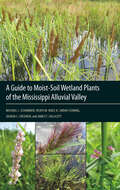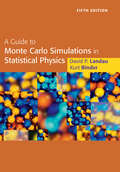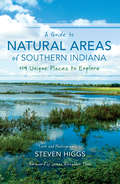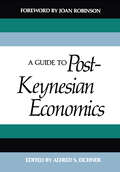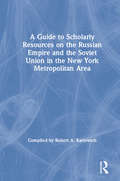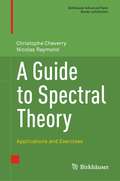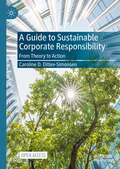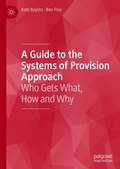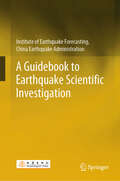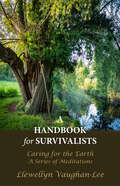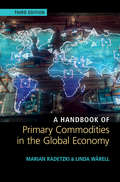- Table View
- List View
A Greene Country Towne: Philadelphia’s Ecology in the Cultural Imagination
by Alan C. Braddock Laura Turner IgoeAn unconventional history of Philadelphia that operates at the threshold of cultural and environmental studies, A Greene Country Towne expands the meaning of community beyond people to encompass nonhuman beings, things, and forces.By examining a diverse range of cultural acts and material objects created in Philadelphia—from Native American artifacts, early stoves, and literary works to public parks, photographs, and paintings—through the lens of new materialism, the essays in A Greene Country Towne ask us to consider an urban environmental history in which humans are not the only protagonists. This collection reimagines the city as a system of constantly evolving constituents and agencies that have interacted over time, a system powerfully captured by Philadelphia artists, writers, architects, and planners since the seventeenth century. In addition to the editors, contributors to this volume are Maria Farland, Nate Gabriel, Andrea L. M. Hansen, Scott Hicks, Michael Dean Mackintosh, Amy E. Menzer, Stephen Nepa, John Ott, Sue Ann Prince, and Mary I. Unger.
A Greene Country Towne: Philadelphia’s Ecology in the Cultural Imagination
by Alan C. Braddock Laura Turner IgoeAn unconventional history of Philadelphia that operates at the threshold of cultural and environmental studies, A Greene Country Towne expands the meaning of community beyond people to encompass nonhuman beings, things, and forces.By examining a diverse range of cultural acts and material objects created in Philadelphia—from Native American artifacts, early stoves, and literary works to public parks, photographs, and paintings—through the lens of new materialism, the essays in A Greene Country Towne ask us to consider an urban environmental history in which humans are not the only protagonists. This collection reimagines the city as a system of constantly evolving constituents and agencies that have interacted over time, a system powerfully captured by Philadelphia artists, writers, architects, and planners since the seventeenth century. In addition to the editors, contributors to this volume are Maria Farland, Nate Gabriel, Andrea L. M. Hansen, Scott Hicks, Michael Dean Mackintosh, Amy E. Menzer, Stephen Nepa, John Ott, Sue Ann Prince, and Mary I. Unger.
A Greener Life: Discover the joy of mindful and sustainable gardening
by Jack Wallington'This is a clearly presented work, with accessible topic headings and plenty of good advice sprinkled with engaging personal anecdotes. The message at the book's heart is to adopt a greener way of being and to see oneself as part of nature, not removed from it. On this point it is exceptional, distinguishing itself from many of the green gardening books written in recent years.' The English Garden magazine'Conversational, interesting, and personal ... it reaffirms the link between what we love to do and why we should be doing it with nature, the planet and our health in mind.' RHS The Garden magazineIf you want a sustainable garden and a better relationship with nature, A Greener Life is the guide you need. Packed with inspirational images and practical tips, the book covers garden planning, organic composting and vegetable growing, as well as sustainable planting, rewilding and wildlife-attracting environments. Learn traditional gardening techniques like propagating and growing from cuttings to make your garden self-sustaining, and discover plants that attract hover flies, bees and butterflies. With Jack Wallington's warmth and expertise on every page, this is an ideal book for new gardeners seeking greener practices.
A Greener Life: Discover the joy of mindful and sustainable gardening
by Jack Wallington'This is a clearly presented work, with accessible topic headings and plenty of good advice sprinkled with engaging personal anecdotes. The message at the book's heart is to adopt a greener way of being and to see oneself as part of nature, not removed from it. On this point it is exceptional, distinguishing itself from many of the green gardening books written in recent years.' The English Garden magazine'Conversational, interesting, and personal ... it reaffirms the link between what we love to do and why we should be doing it with nature, the planet and our health in mind.' RHS The Garden magazineIf you want a sustainable garden and a better relationship with nature, A Greener Life is the guide you need. Packed with inspirational images and practical tips, the book covers garden planning, organic composting and vegetable growing, as well as sustainable planting, rewilding and wildlife-attracting environments. Learn traditional gardening techniques like propagating and growing from cuttings to make your garden self-sustaining, and discover plants that attract hover flies, bees and butterflies. With Jack Wallington's warmth and expertise on every page, this is an ideal book for new gardeners seeking greener practices.
A Guide To U.S. Aircraft Noise Regulatory Policy (Springerbriefs In Applied Sciences And Technology Ser.)
by Sanford Fidell Vincent MestreAviation noise remains the primary hindrance to expansion of airport and airspace capacity in the United States. This book describes the development and practice of U.S. aircraft noise regulation, as well as the practical consequences of regulatory policy. Starting in the pre-jet transport era, the book traces the development of the modern framework for characterizing, standardizing, predicting, disclosing, and mitigating aircraft noise and its effects on airport-vicinity communities. Among other matters, the book treats noise-related consequences of the 1978 deregulation of the airline industry; prediction and mitigation of community reaction to airport noise; land use compatibility planning; recent research and industry trends; and some suggestions for potential improvements to current policy. Initial chapters describe the assumptions underlying aircraft noise regulation, and lay out the chronology of U.S. aircraft noise regulatory practice. Later chapters provide overviews of population-level effects of aviation noise, including health effects, speech and sleep interference, and annoyance. Readers will learn why predictions of the prevalence of aircraft noise-induced annoyance have systematically underestimated adverse community response to aircraft noise, and how such underestimation has complicated approval and funding of airport and airspace improvement projects. They will also learn why attempts at noise-compatible land use planning are seldom fully successful.
A Guide for Desert and Dryland Restoration: New Hope for Arid Lands (Science Practice Ecological Restoration)
by David A. BainbridgeDryland degradation and desertification now affect almost a billion people around the world. Tragically, the biological resources and productivity of millions of acres of land are lost to desertification each year because people remain unaware of strategies and techniques that could improve yields, reduce risk, and begin healing the world's deserts. A Guide for Desert and Dryland Restoration is the first book to offer practical, field-tested solutions to this critical problem. Author David Bainbridge has spent more than 25 years actively involved in restoring lands across the American Southwest. A Guide for Desert and Dryland Restoration presents the results of his years of fieldwork, as well as research and experience from scientists and practitioners around the globe. The book discusses the ecology of desert plants, explores the causes of desertification and land abuse, and outlines the processes and procedures needed to evaluate, plan, implement, and monitor desert restoration projects. It sets forth economical and practical field-tested solutions for understanding site characteristics, selecting and growing plants, and ensuring that they survive with a minimal amount of water and care. Each chapter represents a guide to a critical topic for environmental restoration; extensive photographs, diagrams and drawings give detailed information for immediate application, and additional resources are included in appendixes. A Guide for Desert and Dryland Restoration is the first comprehensive book focused on restoring arid regions, and clearly demonstrates that arid lands can be successfully rehabilitated. In addition to restorationists, the book will be an invaluable resource for anyone working in arid lands, including farmers, ranchers, gardeners, landscapers, outdoor recreation professionals, and activists.
A Guide to Career Resilience: For Women and Under-Represented Groups
by Maria Angela Capello Eve SpruntMentors and sponsors are essential to career success, but these close relationships are not always free from trouble. This book shares advice and practical examples on how to survive and thrive throughout your career by differentiating between good and bad guidance you receive from mentors and sponsors. Real-life guidance is provided on how to manage troubled mentoring and sponsoring relationships at work.
A Guide to Close Binary Systems (ISSN)
by Edwin Budding Osman DemircanIntroduction to Close Binary Systems provides a comprehensive survey and guide to the fast-moving field of multiple, specifically binary, stars, with an up to date account of research around 'close', i.e. interacting pairs. Such interactions allow direct quantification of stellar properties, opening up factual insights into basic building blocks of the Universe.The book provides a much needed update for the seminal Close Binary Systems of Zdenĕk Kopal. Following a comparable plan, it presents relevant subject matter with an emphasis on building a framework of understanding to serve as a supporting resource for students and researchers. The text starts from a general historical background and progresses into the main theoretical ideas supporting our prima facie interpretation of observations. The central chapters explore further into these observational methods, arranged according to the classic subdivisions of astrometry, spectroscopy and photometry. Optimal inversion of observational data into model parametrization is a theme through these chapters. Significant here is the problem of how non-uniqueness in modelling affects interpretation. The underlying issues of stellar evolution bearing on observational evidence become paramount in the last four chapters. The book proceeds step-by-step from directly understandable examples of unevolved pairs to the challenging cases where stars are found in more and more extreme conditions, leading up to the mergers of massive black hole pairs seen in the new field of gravitational wave astronomy. This is a valuable reference for postgraduate and advanced undergraduate students working in mainstream areas of stellar astrophysics, with applications also to exoplanet research which shares some methodological features. Course designers for stellar astrophysics will find a useful selection of topics within this book.Key features:• Provides a well-explained and backgrounded, up-to-date account of close binary systems, in a fast-moving field of research that is growing in scientific importance• Surveys a wide range of case-studies within the context of binary and multiple star systems• Fills an acknowledged gap in current literatureCover Image: A public memorial to Zdenek Kopal in his home town (birthplace) of Litomysl in Czechia.
A Guide to Countries of the World (Revised Second Edition)
by Peter StalkerThe new edition of this invaluable reference work has been painstakingly updated and revised to feature the very latest information in an overview of each country in the world. Up-to-date maps and vital statistics are included for every country. Double-page spreads provide maps and geographical details along side concise overviews of the social, economic, and political issues shaping each country. Global Data tables show social and economic indicators such as GNP, life expectancy, and population growth/density of each country side by side for easy comparison. In today's world changes in geography and demography can have serious short and long-term international implications. No reference work will keep you as up-to-date on the countries of the world as Oxford's latest Guide.
A Guide to Eco-Anxiety: How to Protect the Planet and Your Mental Health
by Anouchka GroseThe first book to tackle the growing phenomenon of eco-anxiety. Written by a psychoanalyst, with a foreword from Caroline Hickman from the Climate Psychology Alliance, this book offers emotional tools and strategies to ease anxiety by taking positive action on a personal and community level.A Guide to Eco-Anxiety outlines a manifesto for action, connection and hope. Showing how to harness anxiety for positive action, as well as effective ways to reduce your personal carbon footprint.The most powerful thing we can do to combat climate change is to talk about it and act collectively. But despite it being an emergency, most people don't bring climate change into conversation in everyday life.The book explores the health impact of experiencing eco-anxiety, grief and trauma, and signposts recommended treatments and therapies. It also tackles practical issues such as: why it's important to reduce plastic waste; parenting and the choice to have a family; which is more effective to bring your carbon footprint down, go vegan or fly less?The book will cultivate a pragmatic form of hope by offering a dynamic toolkit packed with practical ways to connect with community and systemic support, self-care practices to ease the symptoms of anxiety, and strategies to spread awareness and - crucially - bring about change.
A Guide to Empirical Orthogonal Functions for Climate Data Analysis
by Valeria Simoncini Antonio NavarraClimatology and meteorology have basically been a descriptive science until it became possible to use numerical models, but it is crucial to the success of the strategy that the model must be a good representation of the real climate system of the Earth. Models are required to reproduce not only the mean properties of climate, but also its variability and the strong spatial relations between climate variability in geographically diverse regions. Quantitative techniques were developed to explore the climate variability and its relations between different geographical locations. Methods were borrowed from descriptive statistics, where they were developed to analyze variance of related observations-variable pairs, or to identify unknown relations between variables. A Guide to Empirical Orthogonal Functions for Climate Data Analysis uses a different approach, trying to introduce the reader to a practical application of the methods, including data sets from climate simulations and MATLAB codes for the algorithms. All pictures and examples used in the book may be reproduced by using the data sets and the routines available in the book . Though the main thrust of the book is for climatological examples, the treatment is sufficiently general that the discussion is also useful for students and practitioners in other fields. Supplementary datasets are available via http://extra.springer.com
A Guide to Field Instrumentation in Geotechnics: Principles, Installation and Reading
by Richard BassettGeotechnical instrumentation is used for installation, monitoring and assessment on any sizeable project, particularly in urban areas, and is used for recording, controlled remedial work, and safety. This unique and up-to-date book deals with the conceptual philosophy behind the use of instruments, and then systematically covers their practical use
A Guide to Moist-Soil Wetland Plants of the Mississippi Alluvial Valley
by Michael L. Schummer Heath M. Hagy K. Sarah Fleming Joshua C. Cheshier James T. CallicuttMoist-soil wetlands are seasonally flooded areas that produce early-succession plant communities of grasses, sedges, and other herbaceous plants. Moist-soil wetland plants provide food and cover for a diversity of wildlife species, including waterfowl and other waterbirds. Thus, conservation and management of moist-soil plants has become a major component of wildlife conservation efforts in the Mississippi Alluvial Valley and elsewhere in North America. The authors combined their extensive experience working in managed and unmanaged wetlands from southern Missouri to southern Louisiana to produce this beautifully illustrated identification guide. A detailed, yet user friendly field guide to identify moist-soil plants of the Mississippi Alluvial Valley has not been available until now. Management to encourage the growth of moist-soil plants is a common conservation strategy used by state, federal, and private landowners to increase food and cover for wildlife. Thus, landowners must be able to identify moist-soil plants to meet their wildlife conservation goals. Landowners, scientists, wildlife biologists, and students alike will welcome this useful resource which includes 600 detailed color photographs of plants, images of seeds and tubers, and other helpful information to aid in identification. The book includes subsections of major plant groups occurring in moist-soil wetlands including aquatics, grasses, broadleaves, sedges and rushes, trees and shrubs, vines, and agricultural crops.
A Guide to Monte Carlo Simulations in Statistical Physics
by David Landau Kurt BinderDealing with all aspects of Monte Carlo simulation of complex physical systems encountered in condensed matter physics and statistical mechanics, this book provides an introduction to computer simulations in physics. The 5th edition contains extensive new material describing numerous powerful algorithms and methods that represent recent developments in the field. New topics such as active matter and machine learning are also introduced. Throughout, there are many applications, examples, recipes, case studies, and exercises to help the reader fully comprehend the material. This book is ideal for graduate students and researchers, both in academia and industry, who want to learn techniques that have become a third tool of physical science, complementing experiment and analytical theory.
A Guide to Monte Carlo Simulations in Statistical Physics
by David P. Landau Kurt Binder David P. Landau Kurt BinderDealing with all aspects of Monte Carlo simulation of complex physical systems encountered in condensed-matter physics and statistical mechanics, this book provides an introduction to computer simulations in physics. This fourth edition contains extensive new material describing numerous powerful algorithms not covered in previous editions, in some cases representing new developments that have only recently appeared. Older methodologies whose impact was previously unclear or unappreciated are also introduced, in addition to many small revisions that bring the text and cited literature up to date. This edition also introduces the use of petascale computing facilities in the Monte Carlo arena. Throughout the book there are many applications, examples, recipes, case studies, and exercises to help the reader understand the material. It is ideal for graduate students and researchers, both in academia and industry, who want to learn techniques that have become a third tool of physical science, complementing experiment and analytical theory.
A Guide to Monte Carlo Simulations in Statistical Physics
by David P. Landau Kurt BinderThis new and updated edition deals with all aspects of Monte Carlo simulation of complex physical systems encountered in condensed-matter physics, statistical mechanics, and related fields. After briefly recalling essential background in statistical mechanics and probability theory, it gives a succinct overview of simple sampling methods. The concepts behind the simulation algorithms are explained comprehensively, as are the techniques for efficient evaluation of system configurations generated by simulation. It contains many applications, examples, and exercises to help the reader and provides many new references to more specialized literature. This edition includes a brief overview of other methods of computer simulation and an outlook for the use of Monte Carlo simulations in disciplines beyond physics. This is an excellent guide for graduate students and researchers who use computer simulations in their research. It can be used as a textbook for graduate courses on computer simulations in physics and related disciplines.
A Guide to Natural Areas of Southern Indiana
by James Alexander Thom Steven HiggsThis is the first comprehensive and fully illustrated guidebook for nature lovers who want to explore the wild and natural areas of southern Indiana by trail, water, or road. Featuring 95 beautiful color photos and 5 maps, A Guide to Natural Areas of Southern Indiana provides ideas for a lifetime of fun and exploration, and makes planning easy by including directions to the areas, offering suggestions on what to do when you arrive, and what you will find when you explore. Steven Higgs highlights each site's unique natural characteristics and history with additional facts, anecdotes, and observations. Higgs directs readers to the very best locations in southern Indiana for bird and game watching, fishing and boating, hiking and camping, and more. Come and explore the natural areas that represent southern Indiana wilderness at its pristine best!
A Guide to Post-Keynesian Economics
by Alfred S. EichnerDoes there exist an alternative to the “neoclassical synthesis” presented to students in introductory, intermediate, and advanced economics courses? The alternative is the post-Keynesian theory which is the subject of this book.
A Guide to Scholarly Resources on the Russian Empire and the Soviet Union in the New York Metropolitan Area
by Robert A. KarlowichIdentifies collections held by public and university libraries, historical societies, and other institutions, as well as private collections, with material relating to any subject and historical period, and to the widest geographical area under imperial or Soviet rule. Includes movements for example
A Guide to Spectral Theory: Applications and Exercises (Birkhäuser Advanced Texts Basler Lehrbücher)
by Christophe Cheverry Nicolas RaymondThis textbook provides a graduate-level introduction to the spectral theory of linear operators on Banach and Hilbert spaces, guiding readers through key components of spectral theory and its applications in quantum physics. Based on their extensive teaching experience, the authors present topics in a progressive manner so that each chapter builds on the ones preceding. Researchers and students alike will also appreciate the exploration of more advanced applications and research perspectives presented near the end of the book.Beginning with a brief introduction to the relationship between spectral theory and quantum physics, the authors go on to explore unbounded operators, analyzing closed, adjoint, and self-adjoint operators. Next, the spectrum of a closed operator is defined and the fundamental properties of Fredholm operators are introduced. The authors then develop the Grushin method to execute the spectral analysis of compact operators. The chapters that follow are devoted to examining Hille-Yoshida and Stone theorems, the spectral analysis of self-adjoint operators, and trace-class and Hilbert-Schmidt operators. The final chapter opens the discussion to several selected applications. Throughout this textbook, detailed proofs are given, and the statements are illustrated by a number of well-chosen examples. At the end, an appendix about foundational functional analysis theorems is provided to help the uninitiated reader.A Guide to Spectral Theory: Applications and Exercises is intended for graduate students taking an introductory course in spectral theory or operator theory. A background in linear functional analysis and partial differential equations is assumed; basic knowledge of bounded linear operators is useful but not required. PhD students and researchers will also find this volume to be of interest, particularly the research directions provided in later chapters.
A Guide to Sustainable Corporate Responsibility: From Theory to Action
by Caroline D. Ditlev-SimonsenThis open access book discusses the challenges and opportunities faced by companies in an age that increasingly values sustainability and demands corporate responsibility. Beginning with the historical development of corporate responsibility, this book moves from academic theory to practical application. It points to ways in which companies can successfully manage their transition to a more responsible, sustainable way of doing business, common mistakes to avoid and how the UN Sustainable Development Goals are integral to any sustainability transformation. Practical cases illustrate key points. Drawing on thirty years of sustainability research and extensive corporate experience, the author provides tools such as a Step-by-Step strategic guide on integrating sustainability in collaboration with stakeholders including employees, customers, suppliers and investors. The book is particularly relevant for SMEs and companies operating in emerging markets. From a broader perspective, the value of externalities, full cost pricing, alternative economic theories and circular economy are also addressed.
A Guide to the Systems of Provision Approach: Who Gets What, How and Why
by Ben Fine Kate BaylissUnderstanding consumption requires looking at the systems by which goods and services are provided – not just how they are produced but the historically evolved structures, power relations and cultures within which they are located. The Systems of Provision approach provides an interdisciplinary framework for unpacking these complex issues. This book provides a comprehensive account of the Systems of Provision approach, setting out core concepts and theoretical origins alongside numerous case studies. The book combines fresh understandings of everyday consumption using examples from food, housing, and water, with implications for society’s major challenges, including inequality, climate change, and prospects for capitalism. Readers do not require prior knowledge across the subject matter covered but the text remains significant for accomplished researchers and policymakers, especially those interested in the messy real world realities underpinning who gets what, how, and why across public and private provision in global, national, and historical contexts.
A Guidebook to Earthquake Scientific Investigation
by Institute of Earthquake Forecasting, China Earthquake AdministrationThis book concentrates on summarizing previous seismic scientific investigations in order to form standard procedures, approaches, and data sharing for the investigation of future large earthquake. Scientific investigation of large earthquake plays a crucial role in acquiring various records related to earthquake cycle processes and improving the knowledge of earthquake physics and earthquake forecasting. The book aims to provide a guide for the readers seeking earthquake knowledge by probing into the multi-disciplinary investigation of large earthquakes. The book is motivated by recent advances of seismic investigation, including novel geophysical technologies. It is an essential reference to scientifically and systematically investigate future large earthquakes. Chapters are carefully developed to cover seismogenic structure, seismogenic mechanism, earthquake evolution process, influence of the occurred earthquake on regional earthquake hazard, and earthquake disaster mechanism. The book is written for researchers of seismotectonics, earthquake physics, engineering geology, earthquake engineering, natural hazard prevention, and policy-makers engaged in post-hazard restoration.
A Handbook for Survivalists: Caring for the Earth, A Series of Meditations
by Llewellyn Vaughan-LeeWritten while under a wildfire evacuation warning, with bags packed, A Handbook for Survivalists explores the true nature of our survival at this pivotal moment in our shared journey together with the Earth. The present pandemic and its accompanying economic crisis, together with the widespread wildfires and flooding, have shown the fragility of our global systems and a dangerous imbalance with the natural world. Lengthening food lines and burned buildings, smoke-filled skies, have given us a foretaste of a future of climate crisis and radical uncertainty. What are the real values we need at this time when confronted by the divisiveness of our present culture in which the poor suffer most, and how can we transition into a future which respects the more-than-human world to which we belong?Looking deeper than merely physical survival, Llewellyn Vaughan-Lee explores the roots of this present imbalance in our separation from the Earth, and a vital need to reconnect, to regain the knowing of our ancestors who walked on sacred land. Returning to a deep awareness of our interconnected oneness with the living Earth, this book gives us the foundation for a new story for humanity, one not based upon exploitation and greed. A Handbook for Survivalists offers us tools to help in this transition, both in the resilience needed to survive the coming environmental and social breakdown, and in the ways to give birth to a living future. It explores subjects such as destiny, living with chaos, and the central theme of death and rebirth—how to seed a sustainable future for both humanity and the Earth.A Handbook for Survivalists is full of encouragement of how we can transition into this future without glossing over the catastrophes and hardships that we are already encountering. Combining an understanding of the potential for a real shift in consciousness with an awareness of the global forces resisting any such change, Llewellyn Vaughan-Lee takes us on a journey back to when our spiritual nature was bonded with the Earth and its magical nature. This is spiritual empowerment in its deepest sense because it transforms not just the individual but our relationship with the Earth and its diverse community to which we belong.A core element of this empowerment comes from understanding our spiritual nature in relationship to the Earth. Indigenous Peoples live this awareness through prayers, ceremonies, and other practices. We have mostly forgotten this dimension of our spiritual nature, but in our soul and within the world around us is a divine light that is needed to help us heal and nurture the web of life we are destroying. Learning to work with this light—which belongs to mystical and shamanic traditions—we can continue the practice of our ancestors and help to keep the world in balance.Finally this book offers a love story for the Earth. We can help the world remember what our culture has forgotten—how the soil, the seeds, the rivers and the stars all carry a central message of love. In all its diverse forms, its different ways of being and breathing, the living Earth is a celebration of love. And now it is calling out to us, crying to us to remember its sacred nature.
A Handbook of Primary Commodities in the Global Economy
by Marian Radetzki Linda WårellThe dramatic price falls of 2014–2015 marked the end of the most powerful and enduring commodity boom since the Second World War. Now in its third edition, this book acts as a guide to the ins and outs of the primary commodity universe. Updates to this edition reflect on the consequences of both China's economic slowdown as its industrialization enters a new, less commodity demanding phase, and changes in the USA's trade policy under the Trump administration. Additionally, this edition takes into account recent developments in world oil markets and examines the effects of increased climate concerns. The authors introduce and explain pertinent issues surrounding international commodity markets such as the global geography of raw materials, price formation, price trends, the role of commodity exchanges, the threat of depletion, cartel action, state ownership, emerging commodity nationalism and more.
